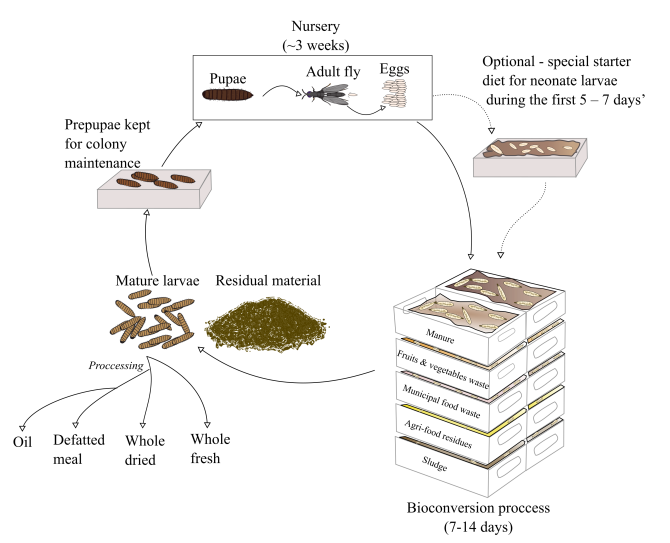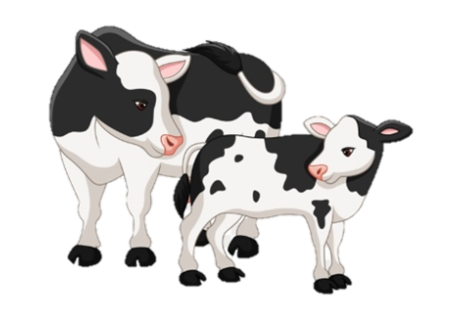
Farmed insects for sustainable food systems
WIAS Magazine - Winter edition 2022
Research Highlight
In this era of climate change and biodiversity loss it is widely acknowledged that food systems need to be reconfigured to avoid further environmental degradation and global food insecurity. One key action needed to reroute food systems towards new sustainable trajectories is to minimize the environmental impact of our diets, and for that, tackling livestock production and consumption and reducing food waste and losses is essential (1).
Insect farming has emerged as a new agricultural sector that aims to help overcoming both challenges (2). The idea is simple: we feed insects with the organic residual streams of our food systems (e.g., food waste, manure, agri-food residues, etc.), and use the resulting insect biomass as food or feed, and their excreta and exuvia as a soil amendment (3). When used as food, the expectation is that insects will substitute livestock products, helping to reduce the consumption of livestock and thus reduce the environmental impact of human diets. When used as feed, insects are expected to replace protein-rich ingredients with high environmental impact such as soybean and fishmeal, and therefore reduce the environmental impact of livestock production, and human diets.
The storyline looks promising. However, to determine whether the use of farmed insects as food and feed will bring environmental benefits for our food systems many knowledge gaps that need to be overcome. My PhD research performed at the Animal Production Systems (APS) group aimed to unravel some of these knowledge gaps to have a better understanding of the environmental implications of using insects as the recyclers of our food systems. Here are the main outcomes.
A reliable quantitative basis of nutrient flows
One of the main activities involved in black soldier fly larvae (BSFL) farming consists of adding a given amount of feed to a rearing crate together with larvae aged between five and seven days old and harvesting the resulting biomass after one to two week-time period (Figure 1). During this period, known as the bioconversion process, the nutrients contained in the feed are either incorporated in the larval body mass, excreted, and lost as gaseous emissions. Our work provided a reliable quantitative basis of these nutrient flows, specifically when BSFL were reared in agri-food residues and pig manure. The quantification of gasses with environmental relevance such as methane, nitrous oxide and ammonia was key to build rigorous environmental impact assessments of BSFL production, and to explore ways of reducing gaseous losses during the bioconversion process.
Our findings showed that gaseous emissions were largely affected by the type of feed in which larvae were reared. When BSFL were reared on agri-food residues, methane, nitrous oxide and ammonia emissions occurring during the bioconversion process were low (4). However, when BSFL were reared on pig manure, the greenhouse and ammonia emissions per kg of larvae were 20 and 48 times higher (5). Does this mean that we should only focus on producing BSF on agri-food residues and discard the idea of feeding BSFL with manure? Absolutely no. Instead, it means that now that we have a reliable quantification of emissions, we should find ways to minimize losses with each specific substrate, and more importantly, to find out if these emissions are lower than those occurring when the residual streams are used for other valorization pathways.

Figure 1. A circular black soldier fly (BSF) production system. Some producers apply strict spatial separation between adult nursery and the mass-rearing. While most BSF producers have their own nurseries to maintain their colonies, specialized farms that commercialize only eggs are emerging.
BSFL can uptake ammonia-nitrogen into their body mass
Studying the nutrient flows occurring when BSFL were reared on manure, we found that 25% of the nitrogen contained in manure was incorporated into the larval body mass, 53% remained in the residual material, and 20% was lost mainly as NH3 emissions (5). Interestingly, we also found that while methane and nitrous oxide emissionsoccurring when BSFL were growing on manure were not different from those of manure without any larvae, ammonia emissions did increase when BSFL were present. To have a better understanding of the nitrogen flows occurring when BSFL were reared on manure, our subsequent study focused on verifying whether the larvae could incorporate ammonia-nitrogen into their body mass. Using the stable isotope ammonium-chloride (15NH4Cl) we found that 13% of isotopic material was incorporated into BSFL body mass, including body proteins (6). These results suggest that BSFL can upgrade ammonia-N contained in manure as protein and therefore contribute to a circular protein supply.
Overall, after studying the nutrient flows and ammonia-N incorporation of BSFL reared on manure, it was concluded that BSFL can simultaneously trigger and mitigate manure ammonia-N emissions. Elucidating how this balance comes about is key for the goal of designing manure BSFL bioconversion systems in which the nitrogen gaseous losses are minimized and ammonia-nitrogen retention in larval body mass is maximized.
Farmed insects can bring environmental benefits but not always
BSFL are envisioned to be fed with organic residual streams and be used as a sustainable source of food and feed. Most existing life-cycle assessments on farmed insects compare the environmental impact of farmed insects with other foods and feeds to determine whether insects can bring environmental benefits (7–9). But we took a different approach because such comparisons do not consider that the streams used as feed for BSFL rearing can have different valorization pathways in the circular economy. Therefore, it was unclear whether using the organic residual streams for BSFL will result in environmental benefits compared to the current uses of such streams. In our modelling study, we quantified the global warming potential (GWP) of BSFL reared on agri-food residues and pig manure using a life-cycle analysis, and compared the outcomes with those occurring from competing valorization pathways in a Dutch context. For the agri-food residues the competing valorization pathway was its use as pig feed, while for manure it was its use as a fertilizer via conventional manure management.
The GWP of BSFL reared on agri-food residues and pig manure was determined mainly by emissions from frass, and gas and electricity use. We found that when reared on agri-food residues, BSFL could only bring GHG benefits if used as food but not if used as feed. Using agri-food residues directly as pig feed would lead to the production of pigs with lower GWP. Furthermore, the GWP of manure bioconversion with BSFL was lower than for conventional slurry manure management, but higher than for manure managed via liquid-solid separation. While further research on frass-related emissions is needed to improve GWP estimations, our results suggest that BSFL bioconversion could bring environmental benefits if properly utilized in the circular economy.
Seven principles for the use of insects as feed
To properly utilize farmed insects for sustainable food systems, we need to use them appropriately and responsibly. In the last chapter of my PhD thesis, written in the format of a comment paper (10), we proposed seven principles to guide the responsible use of farmed insects as feed: 1) prioritize food waste reduction, 2) avoid feeding insects destined for feed with livestock-edible feedstocks, 3) ensure safety, 4) revise regulatory frameworks, 5) optimize insect farming on low-value streams, 6) anticipate trade-offs for productivity, health and sustainability of livestock fed with insects, and 7) account for insect welfare. The comment paper can be freely accessed here.
A 4-year tour and a hand scar
I like to reflect about life using metaphors, and as cycling passionate I see my PhD journey as a 3-week world tour cycling race. Every cycling team riding a world tour race have a lead rider, who is usually the most visible person of the team. But lead riders can only perform well if they have a good team behind their backs. I managed to successfully finalize my own PhD tour because I had such a good team: family and friends that kept me motivated to give my best literally until the end (thesis submitted on the same day my PhD contract terminated!), a great supervision team that provided guidance, and co-authors that helped to improve the quality of the work. If I could only change something, it would be the silly mistake I made that Tuesday afternoon while mixing pig manure with a powerful drill mixer. It costed me five stitches in my hand, a week of antibiotics and a scar in my hand that every time I realize is there, it brings my mind back to that smelly afternoon.
References
1. Steiner A, Aguilar G, Bomba K, Bonilla J, Campbell A, Echeverria R, et al. Actions to transform food systems under climate change [Internet]. Wageningen; 2020. Available from: www.transformingfoodsystems.com
2. van Huis A. Insects as food and feed, a new emerging agricultural sector: A review. J Insects as Food Feed [Internet]. 2020 Aug 27 [cited 2020 Jul 5];6(1):27–44. Available from: https://www-wageningenacademic-com.ezproxy.library.wur.nl/doi/abs/10.3920/JIFF2019.0017
3. Barragán-Fonseca KY, Nurfikari A, van de Zande EM, Wantulla M, van Loon JJA, de Boer W, et al. Insect frass and exuviae to promote plant growth and health. Trends Plant Sci. 2022 Mar 2;
4. Parodi A, De Boer IJM, Gerrits WJJ, Van Loon JJA, Heetkamp MJW, Van Schelt J, et al. Bioconversion efficiencies, greenhouse gas and ammonia emissions during black soldier fly rearing – A mass balance approach. J Clean Prod. 2020 Oct 20;271:122488.
5. Parodi A, Gerrits WJJ, Van Loon JJA, De Boer IJM, Aarnink AJA, Van Zanten HHE. Black soldier fly reared on pig manure: Bioconversion efficiencies, nutrients in the residual material, greenhouse gas and ammonia emissions. Waste Manag. 2021 May 1;126:674–83.
6. Parodi A, Yao Q, Gerrits WJJ, Mishyna M, Lakemond CMM, Oonincx DGAB, et al. Upgrading ammonia-nitrogen from manure into body proteins in black soldier fly larvae. Resour Conserv Recycl [Internet]. 2022 Jul 1 [cited 2022 May 10];182:106343. Available from: https://linkinghub.elsevier.com/retrieve/pii/S0921344922001884
7. Smetana S, Schmitt E, Mathys A. Sustainable use of Hermetia illucens insect biomass for feed and food: Attributional and consequential life cycle assessment. Resour Conserv Recycl [Internet]. 2019 May 1 [cited 2019 Apr 26];144:285–96. Available from: https://www.sciencedirect.com/science/article/pii/S092134491930051
8. Bosch G, van Zanten HHE, Zamprogna A, Veenenbos M, Meijer NP, van der Fels-Klerx HJ, et al. Conversion of organic resources by black soldier fly larvae: Legislation, efficiency and environmental impact. J Clean Prod [Internet]. 2019 Jun 10 [cited 2022 Apr 29];222:355–63. Available from: https://doi.org/10.1016/j.jclepro.2019.02.270
9. Smetana S, Palanisamy M, Mathys A, Heinz V. Sustainability of insect use for feed and food: Life Cycle Assessment perspective. J Clean Prod [Internet]. 2016;137:741–51. Available from: https://doi.org/10.1016/j.jclepro.2016.07.148
10. Parodi A, Ipema AF, Van Zanten HHE, Bolhuis JE, Van Loon JJA, De Boer IJM. Principles for the responsible use of farmed insects as livestock feed. Nat Food 2022 312 [Internet]. 2022 Nov 9 [cited 2023 Jan 17];3(12):972–4. Available from: https://www-nature-com.ezproxy.library.wur.nl/articles/s43016-022-00641-5







